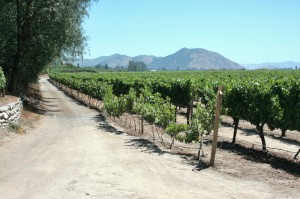 In the 1990s, the wine world’s mania for merlot created an enormous international demand. Chilean wineries, with their fruity-style wines, sold sizable amounts of this easy drinking varietal. One day, a viticulturist noticed an odd difference between the Chilean merlot vines and traditional merlot plantings — the leaves on the Chilean plantings did not look like other merlots. After a few tests, it was discovered that the Chilean plantings weren’t merlot at all. They were carmenere, a grape variety once planted alongside the most famous noble grapes of France’s Bordeaux vineyards, such as cabernet sauvignon and merlot.
In the 1990s, the wine world’s mania for merlot created an enormous international demand. Chilean wineries, with their fruity-style wines, sold sizable amounts of this easy drinking varietal. One day, a viticulturist noticed an odd difference between the Chilean merlot vines and traditional merlot plantings — the leaves on the Chilean plantings did not look like other merlots. After a few tests, it was discovered that the Chilean plantings weren’t merlot at all. They were carmenere, a grape variety once planted alongside the most famous noble grapes of France’s Bordeaux vineyards, such as cabernet sauvignon and merlot.
Chilean winemakers took this potentially scandalous event and turned it into a well-timed opportunity to introduce this unique grape to the world. With Chile’s ideal climate for this grape, and because producers pampered the fruit into a distinct style, Chilean wineries can now claim that its success was no accident.
Just as with the merlot grape for which it was mistaken, carmenere produces a highly approachable wine. With low tannin and low acid, the wine has a soft, fruity mouth feel compared with more tannic red wines. Consumers looking to discover wines outside of the better-known, more “fashionable” grapes, will find carmenere a treat.
THE VALUES
- 2007 Concha Y Toro Carmenere Frontera, Chile (about $9 retail)
- 2007 Root 1 Carmenere, Chile (about $14 retail)
- 2007 Ventisquero Carmenere, Chile (about $10 retail)
- 2007 Santa Rita Carmenere, Chile (about $13 retail)
THE SPLURGES
- 2007 Montes Alpha Carmenere, Chile (about $20 retail)
- 2007 Concha y Toro Marques de Casa Carmenere, Chile (about $22 retail)
- 2005 Concha y Toro Terrunyo Carmenere, Chile (about $48 retail)